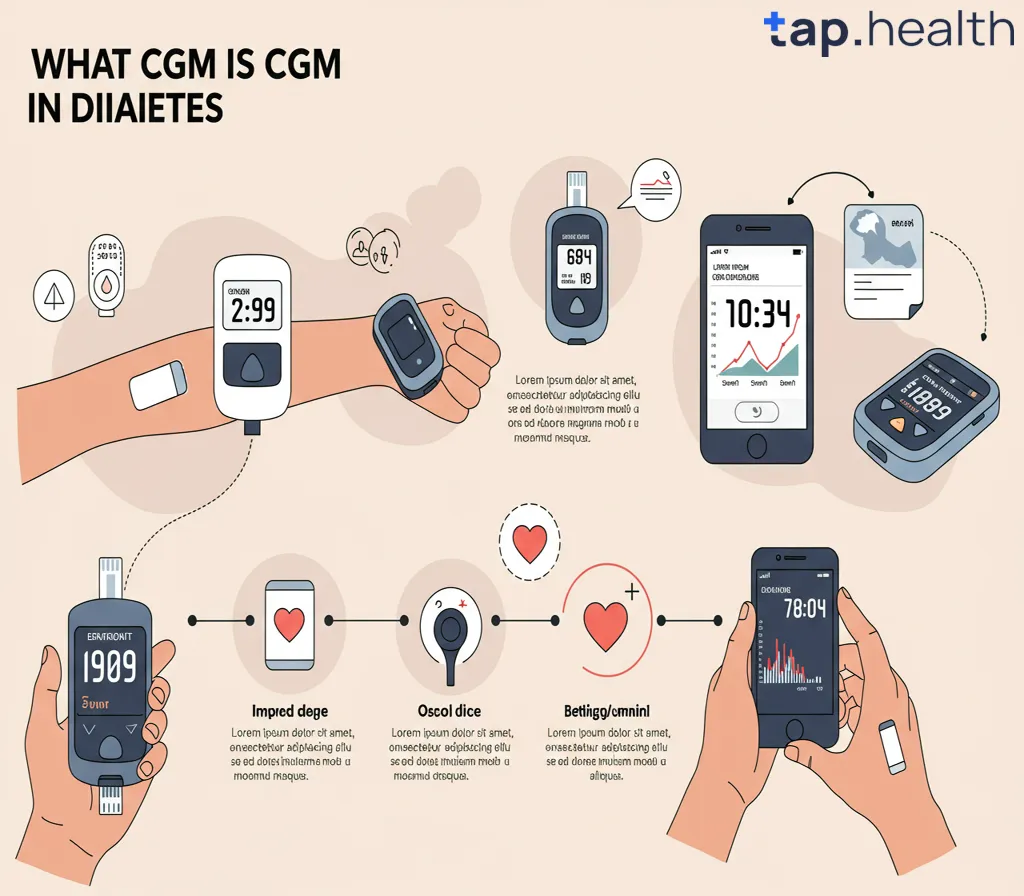Managing diabetes can be challenging, especially when it comes to keeping blood sugar levels in check. Luckily, Continuous Glucose Monitors (CGM) have made diabetes management much easier for people with diabetes. If you’re new to the world of diabetes care or simply curious about CGM, this article will explain what CGM is, how it works, and why it’s a game-changer for many people managing diabetes.
What is a CGM (Continuous Glucose Monitor)?
A CGM is a medical device that helps people with diabetes monitor their blood sugar levels in real time. Unlike traditional glucose meters, which require a blood sample from a finger prick, CGMs continuously measure your glucose levels throughout the day and night. This allows for more accurate, timely information about your blood sugar levels, helping you make adjustments to your treatment plan as needed.
CGMs are typically used by people with Type 1 and Type 2 diabetes to help them better manage their blood sugar. They can be particularly beneficial for those who struggle with frequent blood sugar fluctuations or who experience hypoglycemia (low blood sugar) or hyperglycemia (high blood sugar).
How Does a CGM Work?
A CGM system consists of three main components:
1. Sensor:
The sensor is a small device that is typically placed just under the skin, often on the abdomen or the back of the upper arm. This sensor continuously measures the glucose levels in the interstitial fluid (the fluid between your cells). The sensor usually lasts for 7 to 14 days before needing to be replaced.
2. Transmitter:
The transmitter is attached to the sensor. It wirelessly sends glucose data from the sensor to a receiver or smartphone app. This allows the wearer to view their blood sugar readings in real-time.
3. Receiver or Smart Device:
The receiver can be a standalone device or a smartphone app. It displays the continuous data sent from the sensor, showing real-time glucose levels, trends, and alarms for highs or lows. The receiver also stores this data, allowing for long-term tracking of glucose patterns.
Why is a CGM Important in Diabetes Management?
Managing blood sugar levels is critical for people with diabetes. CGMs offer several benefits that make them a valuable tool in diabetes care:
1. Real-Time Glucose Monitoring
One of the main advantages of a CGM is that it provides continuous, real-time glucose readings. This allows people with diabetes to make immediate adjustments to their diet, physical activity, and insulin doses based on their current glucose levels. Traditional glucose meters only provide a snapshot of blood sugar levels at a specific moment, whereas CGMs give a constant stream of data, which can prevent sudden drops or spikes in glucose.
2. Trend Analysis
CGMs don’t just show a single reading—they also display glucose trends over time. This allows users to see how their glucose levels fluctuate throughout the day and night. For example, if your blood sugar consistently spikes after meals, you can use this information to make changes to your diet or insulin regimen.
3. Early Warning System for Low or High Blood Sugar
One of the key features of CGMs is the ability to send alerts when glucose levels are too high or too low. If your blood sugar is dropping quickly, the CGM will send an alert, allowing you to take action before reaching a dangerously low level. This is especially helpful for people who experience hypoglycemia unawareness, where they may not feel the symptoms of low blood sugar.
4. Improved A1C Control
People with diabetes who use CGMs often experience better overall blood sugar control. Since CGMs provide real-time feedback, they help individuals stay within their target glucose range more consistently, leading to improved A1C levels (the average blood sugar level over the past 2 to 3 months).
5. Reduced Finger Pricks
Traditional glucose meters require frequent finger pricks to get a blood sample. With a CGM, these finger pricks are significantly reduced since the device provides continuous monitoring. Although some CGMs still require a finger prick for calibration, the frequency is much lower compared to traditional monitoring methods.
Types of CGMs
There are different types of CGMs available on the market, each with its own features. Here’s a quick breakdown of the two main categories of CGMs:
1. Real-Time Continuous Glucose Monitors (RT-CGM)
Real-time CGMs provide continuous glucose readings and send alerts when blood sugar levels are outside of the target range. The Dexcom G6 and Freestyle Libre 2 are examples of real-time CGMs. They are most commonly used by people with Type 1 diabetes, although people with Type 2 diabetes also use them.
2. Professional Continuous Glucose Monitors
Professional CGMs are typically used for a short period under the supervision of a healthcare provider. They don’t have real-time alerts and are mostly used for data collection. After a few days of monitoring, the data is reviewed by a healthcare professional to provide insights into how blood sugar levels are behaving over time.
Benefits of Using a CGM
The benefits of using a CGM go beyond just monitoring blood sugar levels. Below are some of the most notable advantages of using a CGM:
1. Better Blood Sugar Control
CGMs help provide better insulin dosing and meal timing decisions. By knowing when your blood sugar is rising or falling, you can make more informed decisions about when to eat, exercise, or take insulin.
2. Reduced Risk of Complications
By consistently monitoring glucose levels, people with diabetes can avoid extreme fluctuations that could lead to long-term complications such as nerve damage, kidney disease, and heart disease. Stable blood sugar levels can help lower the risk of developing these complications.
3. Convenience
CGMs are less invasive than frequent finger pricks. People with diabetes, especially children and older adults, find the convenience of not having to prick their fingers multiple times a day to be a major advantage.
4. Data Sharing
Many CGM devices come with the ability to share data with healthcare providers, caregivers, or family members. This feature is particularly helpful for children or elderly individuals who need assistance in managing their diabetes. It allows for remote monitoring and ensures that someone is always keeping an eye on the blood sugar levels.
Challenges of Using a CGM
While CGMs offer many benefits, they also come with some challenges that should be considered:
1. Cost
One of the main drawbacks of CGMs is their cost. While prices vary depending on the brand and the type of insurance coverage, CGMs can be expensive, especially for people without insurance or with high deductibles. The sensor, transmitter, and receiver may all need to be replaced periodically, which can add to the overall cost of using a CGM.
2. Sensor Accuracy
CGMs are highly accurate, but they are not perfect. Occasionally, the sensors may give false readings or need calibration. It’s important to remember that CGMs are meant to be used as a guide, not a replacement for blood glucose testing.
3. Skin Irritation
Some people may experience skin irritation or rashes at the site where the sensor is attached. It’s important to follow the instructions for proper sensor placement to reduce the risk of skin irritation.
FAQ about CGMs in Diabetes
Q: How does a CGM help with blood sugar control?
A: A CGM helps by providing continuous glucose readings, showing trends in real-time. This allows users to adjust their insulin doses, diet, and exercise habits to stay within their target blood sugar range.
Q: Are CGMs available for both Type 1 and Type 2 diabetes?
A: Yes, CGMs are available for both Type 1 and Type 2 diabetes. They are especially helpful for people who have difficulty controlling their blood sugar or experience frequent fluctuations.
Q: How often do I need to change the sensor on a CGM?
A: Sensors typically last between 7 to 14 days, depending on the device you are using. After that, they need to be replaced.
Q: Can I use a CGM without a doctor’s prescription?
A: In most cases, a prescription is required to get a CGM. However, some companies offer professional CGMs that may be available without a prescription for short-term monitoring under the supervision of a healthcare provider.
Q: Are CGMs suitable for children with diabetes?
A: Yes, CGMs are suitable for children with Type 1 diabetes, and they can help make managing blood sugar levels easier for both children and parents.



